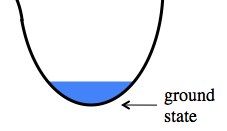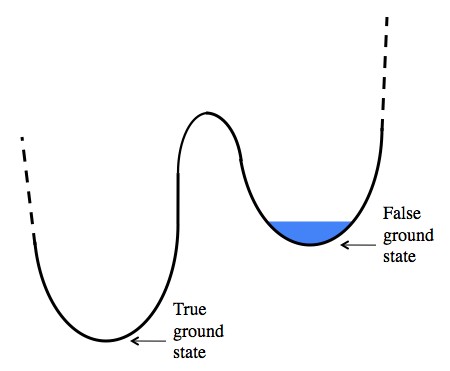Physicist: The False Vacuum is just another item on the long list of things to worry about, that are not worth worrying about, and that nobody can do anything about. If you have any other worries, worry about those first.
In any physical system you’ll find that there’s an energy “ground state” that the system tries to approach. For example, if you pour water into a bathtub there are a lot of ways that the water could arrange itself, but it will rapidly try to assume the ground state: being as low and still as possible.

In any physical system there’s a lowest energy state called the “ground state”. If you allow the energy to drain out of a system, then it will approach its ground state.
Gravitational potential (the energy that something on a high shelf has more of, and that’s released when things fall) is the easiest example of an energetic system to picture. Being on the ground is the lowest gravitational potential a thing can have (without digging); thus the name.
But in the tub example, the water in the tub doesn’t “know” about the drain or the area around the tub. Given the chance the water would flow out of the tub and into a new, lower, ground state. In fancy-math-speak, you’d say that the water in a tub is in a “local energy minimum”. Within the tub, water definitely assumes the only ground state it can find. However, if it jumped out of the tub, or somebody pulled the plug, then it would try to find a new, lower ground state and would find that it gained a bunch of new energy in the process (what with the flowing and splashing and whatnot).
The idea of energy levels, and ground states, and all that, applies to pretty much everything. That includes electromagnetic fields and even particle fields. A “particle field” is the quantum mechanical way of describing particles (all smeared out, instead of being all in one point), and each field has a pretty reasonable set of energy levels. Every new particle elevates the energy level by one step, and the ground level is exactly what you’d expect: zero particles.
The vacuum is the most absolute ground state: no waves, no particles, nothing at all to elevate the energy above zero*. However, all the dynamics of the universe are governed by differences in energy level. For example, when you fill a tub it doesn’t matter if the tub is at the top of a mountain, or at the bottom of a mine, the water will behave the same way. So, the idea behind a false vacuum is that what we consider the ground state of the universe isn’t really the ground state, and it may be possible to drop into an even lower-energy state (drain the tub, so to speak). What we think is the ground state, the vacuum, may not be the true ground state. So it’s called a “false vacuum”.
The “danger” of living in a false vacuum is that, under the proper circumstances the false vacuum can drop into the true vacuum. The cause is usually described as a sufficient burst of energy to get the appropriate fields “over the hump” (picture above). If the difference in energy between the false vacuum and true vacuum is large enough, then the surrounding space can likewise be tipped into the lower state. In theory, a “false vacuum collapse” would expand at light speed (or about light speed) from the originating event, and destroy the heck out of everything in the affected, and ever-expanding, region.
It’s worth mentioning that the idea of a false vacuum is wild speculation and that there is no indication, not even a little, that the vacuum of the universe is a false vacuum and not the true ground state. There’s a long history of spectacular bursts of energy in the universe, and none of them have tripped a collapse. The ground state of the universe is kinda like a septuagenarian’s testicle; if it hasn’t dropped by now, it probably won’t.
*For subtle reasons, it turns out that you can’t quite reach zero and as a result the vacuum state has slightly more than zero energy. This tiny difference is known as the “vacuum energy” or “zero point energy”, and it’s responsible for things like the Casimir effect. By the way, there are some significant issues to work out involving a disagreement between the measured and predicted values of the vacuum energy.








Pingback: Proof that the Universe Could have Come from Nothing?
Pingback: Pick Your Doomsday: 9 End-of-the-World Theories that Will Haunt Your Dreams | Tales from the Conspiratum
Pingback: Pick Your Doomsday: End-of-the-World Theories that Will Haunt Your Dreams - PRN.fm - PRN.fm
Pingback: How Will the Universe End? Here Are 4 Possibilities – 练习猫
Pingback: “How Will the Universe End?”- Possibilities – – Town of MHF
Pingback: How Will the Universe End? Here Are 4 Possibilities – Scivenger